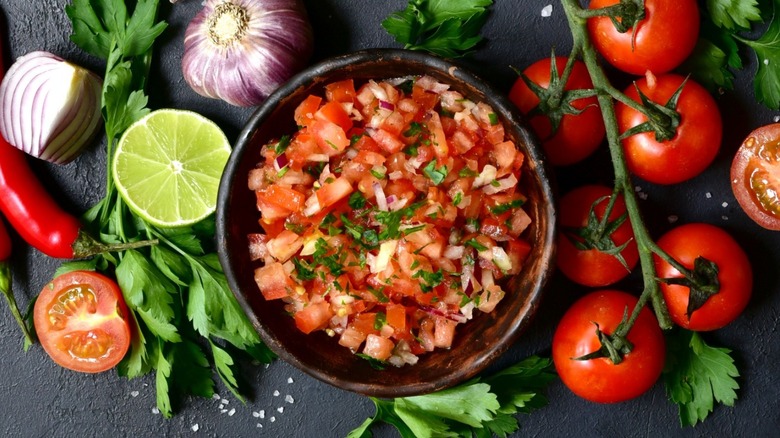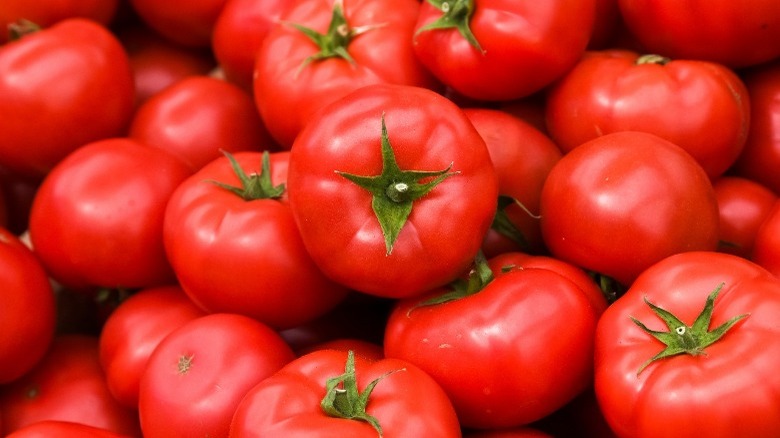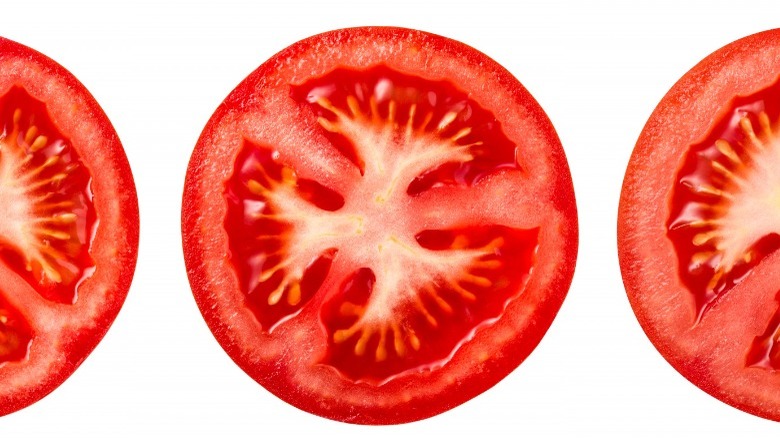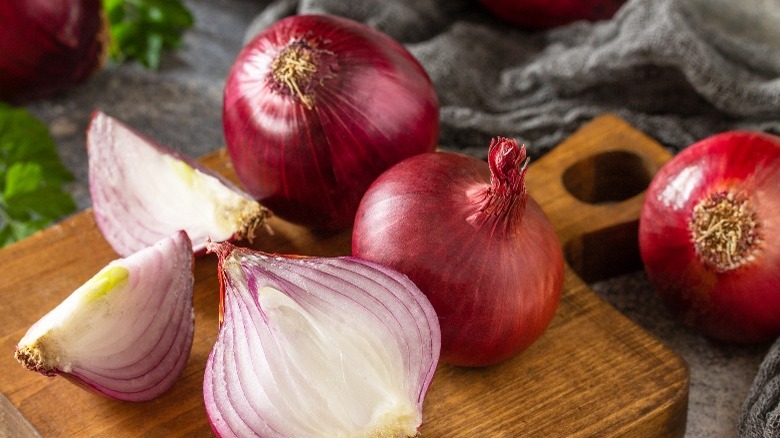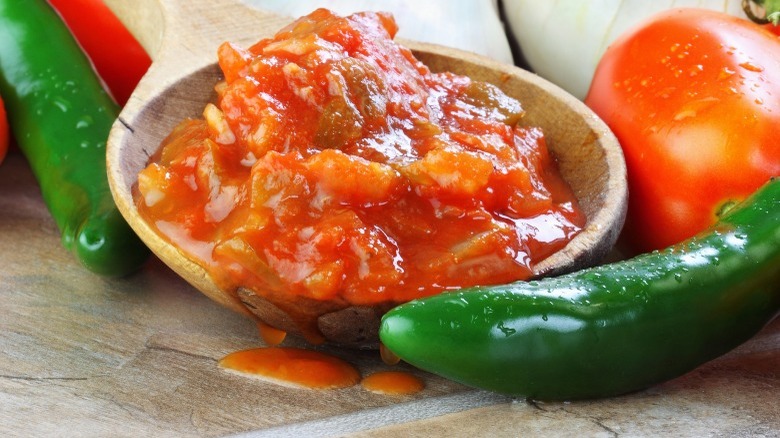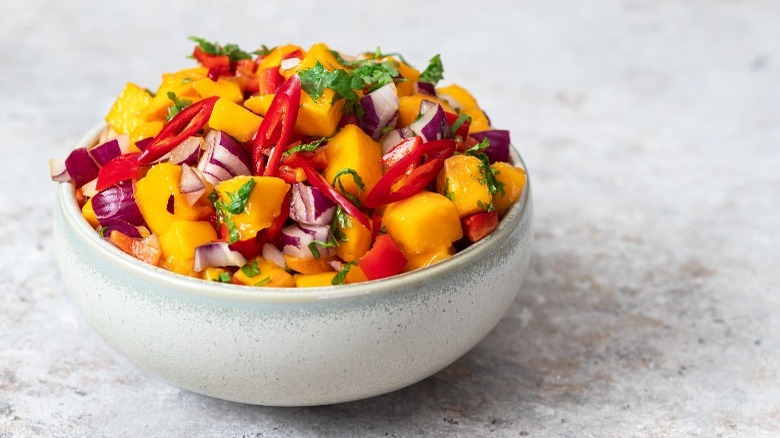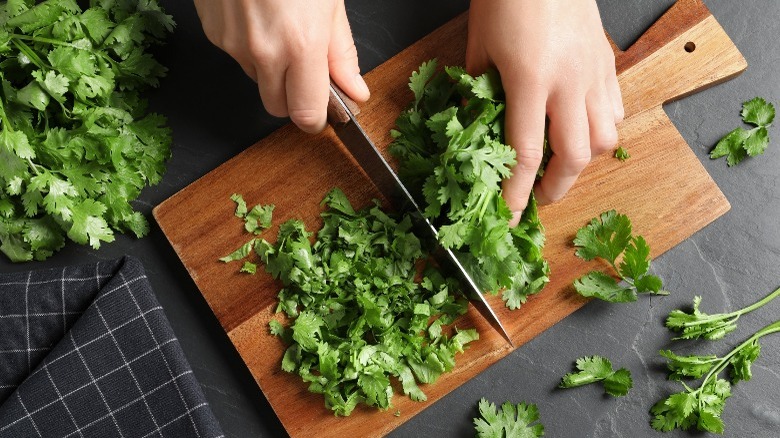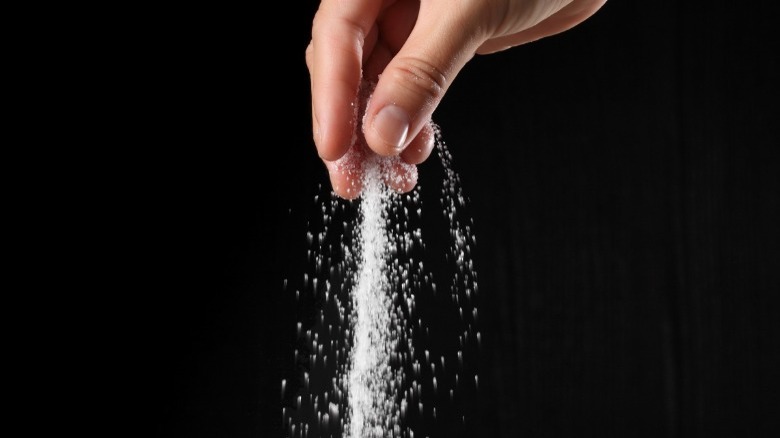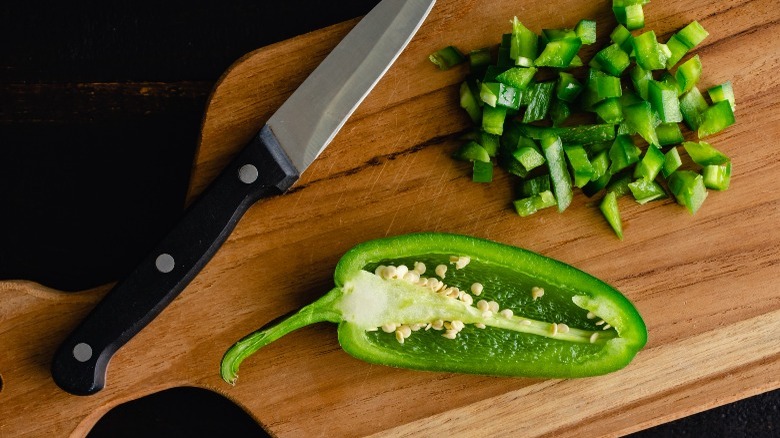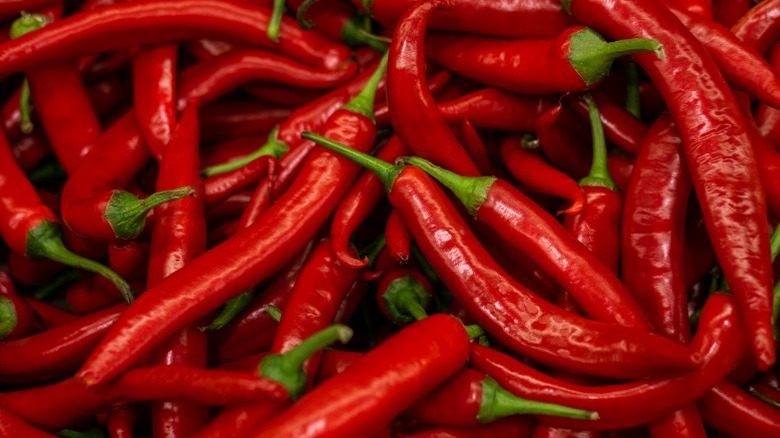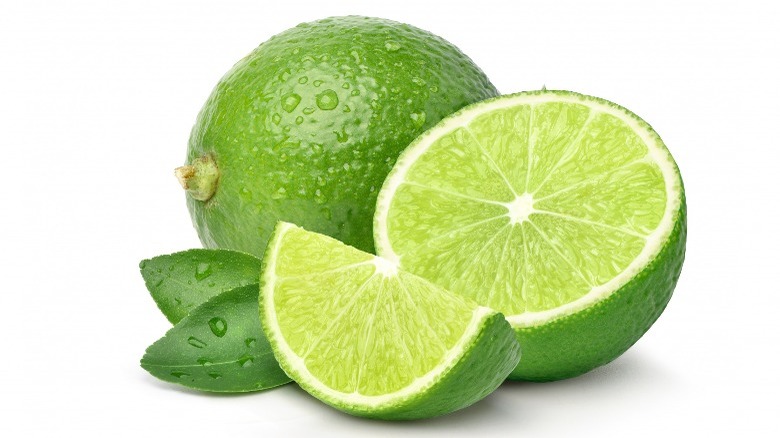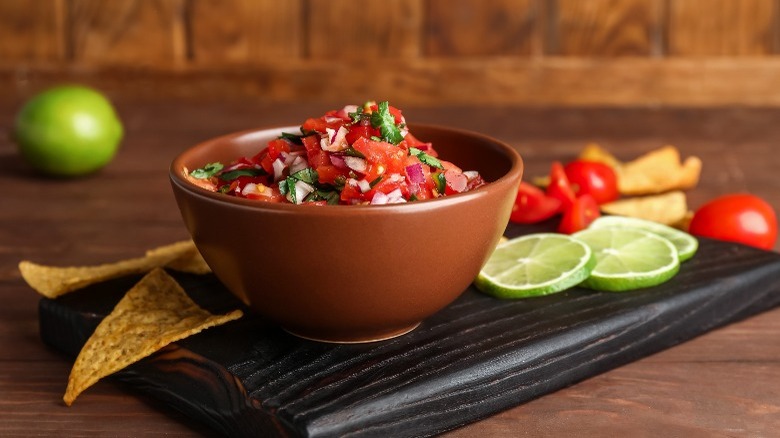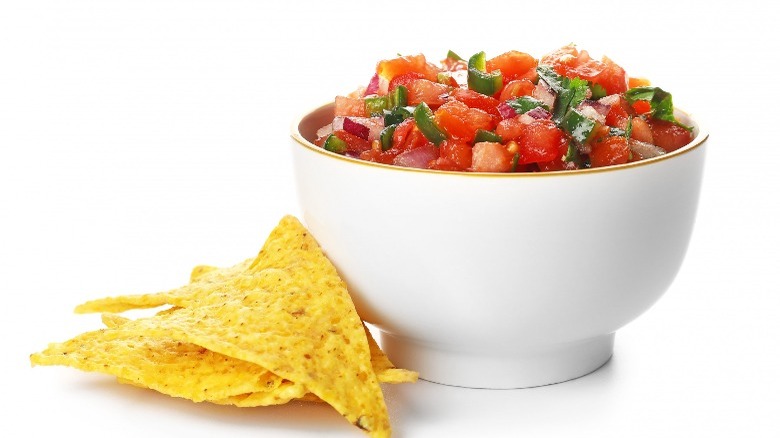Mistakes Everyone Makes When Making Homemade Salsa
Salsa has become such a beloved food that NBC News called it a condiment-slash-side-dish that's more popular than ketchup. And why shouldn't it be? It's a blend of fresh vegetables and seasonings that not only tastes great but also makes a healthy alternative to standard dips, as well as a versatile addition to the dinner table as an accompaniment to a slew of other dishes. If we're going to call it a condiment or a side dish, we might as well call it a salad too, considering the garden goodness that goes into a well-made salsa.
Though it's inexpensive and easy to get at the grocery store, sometimes jar salsa just won't cut it. In these desperate moments, homemade salsa is a tempting option and one that doesn't seem difficult at first glance. Grab a couple of tomatoes, some onions, and a sprinkle of herbs, throw it all into the Vitamix, and boom — a tasty topping for your tortilla chips, tacos, or nachos. But success isn't guaranteed, and salsa failure is often the result of some common errors. With a little forethought and the list that follows, you can avoid these mistakes everyone makes when making homemade salsa.
Using the wrong tomatoes
Tomatoes are the biggest presence in salsa, so you don't want to get off on the wrong foot with these ruby-hued beauties. A primer on the Pioneer Woman website differentiates between using Roma tomatoes for a restaurant-style salsa, or salsa roja, and using something sturdy like a beefsteak tomato for pico de gallo, also called salsa fresca, where diced tomato pieces are crucial. As she explains it, "These tomatoes have denser flesh, fewer seeds and little water, making them perfect for chunky salsas."
You can grow your own tomatoes for a salsa with unbeatable flavor, provided you know which varieties to plant. Bountiful Gardner recommends San Marzano, Juliet grape-style, and an heirloom tomato called Amish Paste, which are meaty options among red tomatoes. They are all fleshy tomatoes with less water and seeds than other varieties. They're similar to Roma and will play nicely with your other ingredients.
If canned tomatoes enter the equation, Boss the Kitchen notes that these are "best for smooth restaurant-style salsas," rather than a salsa fresca, where fresh ingredients make the difference between a fiasco and a fiesta.
Not removing the tomato seeds
The debate over whether to remove the seeds from tomatoes before making salsa may come down to a matter of convenience. But seeds can add a weird texture element that isn't welcome in the mix. As Pure Wow puts it, "They're the culprits that make your dish extra gooey and watery, which can ruin the consistency of the recipe." It doesn't sound like a fun surprise when you're preparing to serve a house filled with hungry guests.
Fresh Food Bites offers some handy tips for taking out tomato seeds to improve your salsa. Removing the seeds prevents any excess water that the seeds and their surrounding gel can add once the bowl sits to allow the flavors to meld. The difference is minimal after an hour, but after a full 24 hours, your salsa fresca is likely to become a salsa mess-ca. Since the task is a must, the easiest way to remove the seeds is to cut the tomato into quarters and scoop out the centers with a spoon. The benefits of having a salsa that isn't soup are well worth the extra step.
Using the wrong onions
While onions are a definite member of the salsa team, the type of onion you use can make a difference in the overall body and flavor of your salsa. There may be little visual distinction between a brown onion and a yellow onion when you're head-down over your grocery cart in the produce section, but the impact on your salsa will make you regret not looking up from your list to make the right choice. And a salsa made with the wrong onions equates to moments in your life you'll never get back.
Cooking Light helps out with the onion decision by pointing out that red or white onions are best for salsas of all types. Both of these onions do well as raw ingredients, adding flavor and a bit of a kick without overpowering or getting lost in the blend. And a few snips of green onions as garnish in a bowl of both salsa fresca and salsa roja are always a welcome addition. No wasted moments here!
Making it too watery
We've all had a watery salsa experience, where our chip dissolves in the liquid and lets whatever remains fall onto the plate ... or the floor. With so many juicy ingredients going into the bowl, having too much liquid in your mix is a recipe for disaster. The remedy might take an extra step or two, but the juice is worth the squeeze. Or in this case, the juice removal is worth the squeeze.
Home Cook World provides the run-down on runny salsa. Tomatoes are an obvious offender, which makes removing the seeds a must in the struggle against excess liquid. If it's still wetter than necessary, drain the tomatoes overnight to remove as much as possible. Once mixed, if your salsa still seems thin, you can add avocado to thicken it up. This will obviously alter the flavor, but not necessarily in a bad way.
No matter what measures you take, after your salsa sits for a while, there's bound to be juice in the bottom of the bowl. It's just the nature of the beast. Don't hesitate to drain it off, though sometimes stirring it back into the mix can refresh the flavor.
Adding the wrong amount of acid
Acid provides the zing and zest salsa lovers crave. The basic ingredients in salsa are acidic in nature, which makes the whole combination a potential acid fest. Tomatoes, onions, garlic, peppers, and citrus all impact the overall acidity in the bowl. Some recipes call for vinegar, which washes the already-acidic ingredients in an acid bath. As educators at the University of Connecticut point out, the acidity of your salsa actually helps preserve it. This is great news when you're canning or preserving salsa for future use. Though acid is a necessary element in a proper salsa, there can definitely be too much of a good thing.
The best approach to limiting the acid in your salsa is to avoid including it in the first place. Per Simply Delicious, the riper the tomato, the lower the acid, which tilts the scale in favor of home-grown tomatoes. Citrus adds a kick, but it can be added in moderation or omitted entirely. Vinegar is an extra that can stay in the bottle. If sweet salsas are on your list of favorites, adding a sugary ingredient like mango can help compensate for too much acid.
Not using fresh herbs
Herbs add the exciting top notes to any salsa. But dried herbs from a shaker lack the flavor that a selection of fresh herbs can provide. And leaving them out altogether is a missed opportunity. The right fresh herbs can finish off the savory garden-party feel of your salsa without upsetting the beautiful vegetable balance you've achieved. Luckily, you can take your salsa from "what now?" to "holy cow!" with just a few thoughtful purchases from the produce section.
Cilantro is a staple in salsas, though the flavor can be off-putting to sensitive salsa lovers. The Spice House notes that Mexican oregano or Thai basil can be satisfying replacements. And the Gardening Channel suggests planting basil, parsley, and oregano as part of a salsa garden to bring in freshness. This will provide a ready supply of fresh, organically grown herbs you can always have on hand. Even a few herb pots in your kitchen can help turn up the flavor volume on your rock star salsas.
Using the wrong amount of salt
Add too much salt to your salsa and it's all you can taste. Add too little and the veggies and herbs can come across as a little bland. The right sprinkle brightens background flavors and evens out the foreground tastes. In short, salt is a salsa unifier, and using the wrong amount is a make-it-or-break-it situation. It isn't just the amount that matters. Smithsonian Magazine notes that the grain of salt is equally important. Table salt includes iodine that can alter the flavor of your salsa. Choosing a coarser salt like sea salt or even kosher salt can bring the magic you're looking for.
Of course, how much salt you include is a matter of taste. If by some horrible accident you add too much in your pursuit of just enough, Share Post offers some suggestions for salvaging a salty salsa. Adding acid or increasing the bulk ingredients like onions or cucumbers can help reduce sodium levels. Tossing in a dairy ingredient like cheese or sour cream can neutralize the salty flavor, too. If all else fails, you can turn it into spicy pasta sauce.
Leaving out the jalapeños
The fun flavor of jalapeños can add dimension to a so-so salsa. But not everyone can stand the heat, and a mouthful of pepper heat can blunt the rest of the flavors and take the punch out of a perfectly lovely dip. Fortunately, there are clever ways to include these peppy green peppers in the salsa fun without scorching your tongue or searing the roof of your mouth.
As Spruce Eats explains, capsaicin, the real heat-bringer in jalapeños and other peppers, resides in the pithy white interior and the seeds. By scraping them out, you lose the painful heat while retaining the vibrant green flavor. You can also soak cut jalapeños in a bath of three parts water to one part vinegar for an hour to extinguish the fire. Serving your salsa with a side of creamy ingredients such as sour cream or crema fresca will also help reduce the heat.
Making it too hot
There is always a chance that the pepper quotient in your salsa will be overwhelming and the heat will be too much to take. It's a rookie mistake, and one you won't make more than once or twice as you learn to balance your flavors and prepare your ingredients properly. Rather than toss a perfectly good mix that just happens to offend with its heat, you can keep a few pro tips in your recipe book that might save the day and salvage your salsa.
Foods Guy comes to the rescue with some clever hacks to de-heat your salsa. The easiest solution: dilute the salsa by adding more non-spicy ingredients, or even cucumber or avocado. Adding lime juice to ramp up the acidity can also take the sting out of the peppery parts. Fruit elements like mango and pineapple will bring in sweetness that tempers the spiciness, and even a sprinkle of sugar is a possibility. The only way to find out is to use the time-honored method of try-and-taste until you settle on a warmth that works.
Not adding citrus
Sometimes, you don't realize the vital zing that citrus can add until you take the first taste of a salsa made without it. The blend of mellow, sweet, spicy, and fresh just isn't the same without a tongue-tingling sparkle of citrus dancing with the other flavors. A simple squeeze can add life to a slumbering salsa that just can't seem to wake up, no matter how many other ingredients you toss into the bowl.
The answer is to always have citrus on hand for your salsa celebrations. Easy, right? Sure ... unless it's party time and you're out of limes and out of time. Luckily, there are other citrus substitutes that can step in for an assist. Best Substitute For offers lemon, orange, or grapefruit as an alternative. While these may shift the flavor profile you're going for, they'll bring in the zest you're hoping to achieve. You can also add either white or apple cider vinegar for a kick that won't take your salsa too far afield.
Not letting it marinate
The magic of salsa is in the mixing and mingling, all of which happens after the busywork of chopping, de-seeding, and blending. But if you're making salsa to be enjoyed immediately upon completion, you're cheating yourself out of a whole world of flavor that comes from allowing the elements to get better acquainted before they hit the table.
Life Hacker says that ideally, your salsa should marinate overnight to reach optimal flavor potential. But letting a just-okay salsa marinate for even an hour before serving it can turn it into something special. Knowing you'll need extra time to put on the extra razzle-dazzle should help you time your salsa prep for whatever the occasion calls for. If you're just snacking and you can't wait, by all means, dig in. If you have people to impress with your salsa skills, plan ahead and prepare a properly marinated salsa that will keep them coming back to the bowl.
Serving it at the wrong temperature
Figuring out the right temperature for serving your salsa can be a bit of a challenge. Putting a bowl of cold salsa on the table can result in less-than-ideal flavor. But leaving it out to warm too much can bring out extra juices that make it slimy ... and that's not to mention the bacteria factor.
The Santa Cruz Sentinel reports that salsa is essentially a condiment salad, which is best served at room temperature. While some salsa recipes may be made from cooked ingredients, that doesn't mean they should be served straight out of the pot. A salsa taken directly from the fridge should be given time to warm up a little, and a salsa that has been heated should take a few minutes to chill out. Somewhere in the middle is the perfect temperature for tasting all the incredible work that went into that salsa. It's moments like this that make life worth living.
